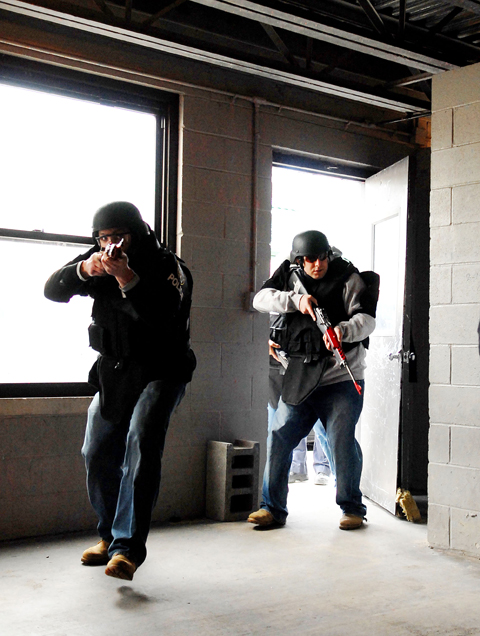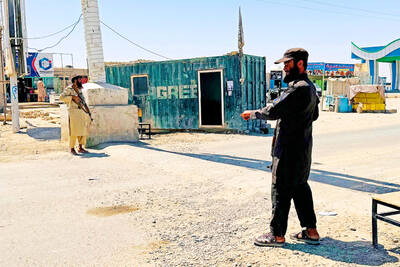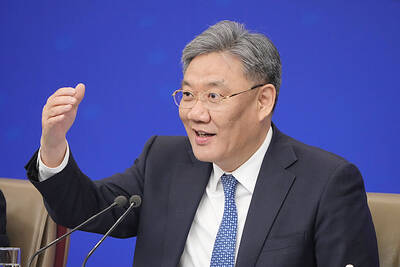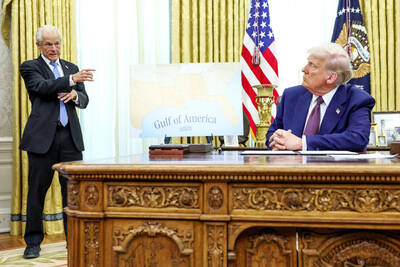The team of police officers crisscrosses down a New York City block, bracing for a potential firefight with heavily armed suspects who have taken hostages inside a building.
“We know there are hostages in there,” Lieutenant Kenneth Beatty warns while supervising the operation. “The number’s unknown.”
It’s not real, but it’s not a standard training session, either.

PHOTO: AP
Local authorities believe New York City could be a potential target of militants trained and supplied as well as those who staged coordinated attacks in Mumbai last November, and New York Police Department leaders are determined not to be outgunned.
“Terrorists are thinking creatively about new tactics,” Police Commissioner Raymond Kelly said last week at a City Council public safety hearing. “So must we.”
The largest US police department launched a counterterrorism initiative this month to train a new team of officers with semiautomatic rifles loaded with armor-piercing bullets.
The officers also are being trained in tactics for close quarters combat and rescuing hostages in hotels and other high-rise buildings.
After the three-day assault in Mumbai on luxury hotels, a Jewish center and other sites in November left 164 people dead, the NYPD dispatched investigators to India to see if there were any security lessons for New York. They were struck by how the 10 shooters calmly caused so much mayhem by relying on cellphone communication and Chinese knockoff AK-47s. The local police and security officers, they said, were clearly overwhelmed.
“Their weapons were not sufficiently powerful and they were not trained for that type of conflict,” Kelly said. “It took more than 12 hours for properly armed Indian commandos to arrive.”
The NYPD’s 400 Emergency Service Unit officers already can carry fully automatic Colt M4 rifles — what the manufacturer bills as “the weapon of the 21st century soldier.”
But post-Mumbai, the department decided to train about 130 reinforcements from its Organized Crime Control Bureau with Ruger Mini-14s in case a militant force even larger than the one that struck India’s financial capital invaded here. Police academy recruits will get a tutorial on how to secure assault weapons recovered in combat situations or, in a pinch, how to shoot them.
The NYPD also has begun videotaping the interiors of large hotels so emergency service officers can learn their layouts and match wits with terrorists who, as in Mumbai, may have done surveillance.
In addition, Kelly told the city council that the police want to explore ways to disrupt cell phone service “in a pinpointed way against terrorists who are using them.”
The training session last week took place at the police department’s firearms training facility on a desolate, wind-swept peninsula in the borough of the Bronx.
The street the officers crisscrossed is the NYPD version of a movie studio back lot, with mock street signs, cinderblock storefronts, even a yellow cab and city bus. The guns can’t fire. The hostages are played by other officers.
Instructors drilled officers on how to rescue hostages while giving each other cover.
They warned that terrorists could try to blend in with victims. Any lapse in concentration could prove deadly.
“You guys have to communicate!” one instructor yelled as the officers secured a darkened stairwell as an escape route.
At a nearby firing range, another set of officers used their assault weapons to blast away at targets. They would shoot 600 rounds over two days to complete the training.
Some of the guns were purposely rigged to suddenly fire blanks — a signal to the officers to practice dropping a jammed weapon and immediately draw their semiautomatic pistols and keep shooting.
The exercise was another sign of a new era in policing, said Assistant Chief George Anderson, commanding officer of the police academy.
“We’ve always been prepared to deal with criminals, not terrorists,” Anderson said. “Now we have to go to the next level.”

‘EYE FOR AN EYE’: Two of the men were shot by a male relative of the victims, whose families turned down the opportunity to offer them amnesty, the Supreme Court said Four men were yesterday publicly executed in Afghanistan, the Supreme Court said, the highest number of executions to be carried out in one day since the Taliban’s return to power. The executions in three separate provinces brought to 10 the number of men publicly put to death since 2021, according to an Agence France-Presse tally. Public executions were common during the Taliban’s first rule from 1996 to 2001, with most of them carried out publicly in sports stadiums. Two men were shot around six or seven times by a male relative of the victims in front of spectators in Qala-i-Naw, the center

Canadian Prime Minister Mark Carney is leaning into his banking background as his country fights a trade war with the US, but his financial ties have also made him a target for conspiracy theories. Incorporating tropes familiar to followers of the far-right QAnon movement, conspiratorial social media posts about the Liberal leader have surged ahead of the country’s April 28 election. Posts range from false claims he recited a “satanic chant” at a campaign event to artificial intelligence (AI)-generated images of him in a pool with convicted sex offender Jeffrey Epstein. “He’s the ideal person to be targeted here, for sure, due to

DISPUTE: Beijing seeks global support against Trump’s tariffs, but many governments remain hesitant to align, including India, ASEAN countries and Australia China is reaching out to other nations as the US layers on more tariffs, in what appears to be an attempt by Beijing to form a united front to compel Washington to retreat. Days into the effort, it is meeting only partial success from countries unwilling to ally with the main target of US President Donald Trump’s trade war. Facing the cratering of global markets, Trump on Wednesday backed off his tariffs on most nations for 90 days, saying countries were lining up to negotiate more favorable conditions. China has refused to seek talks, saying the US was insincere and that it

As Elon Musk called one of US President Donald Trump’s top economic aides a “moron,” the White House on Tuesday declared that “boys will be boys.” Musk and long-time Trump trade adviser Peter Navarro have been squabbling publicly over Trump’s decision to impose sweeping tariffs on most of its trading partners. The move has triggered a market sell-off and prompted analysts to wonder if the US is headed into a recession. “Look, these are obviously two individuals who have very different views on trade and on tariffs,” White House press secretary Karoline Leavitt said. “Boys will be boys, and we